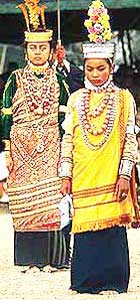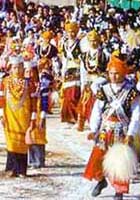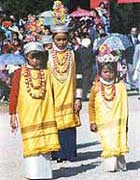This is the most important festival of the Khasis in Meghalaya.Nongkrem
a five daylong colourful festival is held annually in November at Smit,
the capital of the Khyrem Syiemship near Shillong. It is a
religious festival for thanksgiving to the all-powerful God- U Blei
Nongthaw-Nongbuh for a bountiful harvest and to pray for peace
and prosperity to the community.
The Syiem of Khyrim,
custodian of the original animistic religion in a society that is now
mostly Christian, hosts the Nongkrem dance. Syiems, or kings of the
Khasi hill regions are still among India's last remaining royalty.Ka
Syiem Sad the eldest sister of the king is the State priestest
who helps the King to preside over the ceremonies.
An important part of this festival is Pomblang (sacrifices of goats)
Ceremony, at which goats offered by citizens and subjects of the whole
kingdom to the Syiem'of Khyrim, are slained and offerings are
made to the ancestor of the ruling clan and the deity of Shillong peak
(U-Lei Shillong).
A part of the ritual is the sanctification ceremony of the Tangmuri
(pipes) as queen of the musical instruments, After the religious
rituals, on the fourth day, Khasi men and women, dressed in
traditional splendour, perform the famous Nongkrem dance.
At day-break on that day a maiden
dance is held in which virgins from the Syiem house take part and the
Syiem Sad shaded by an umbrella, dance with great solemnity.
This is called an opening dance or royal dance, which is generally
done by the 'Syiem' before the public dance starts.
For the Nongkrem dance, young lads
brilliantly clad in colourful silk dhotis, coat and a plumed turban,
adorning glittering ornaments dance around with a sword or spear in one
hand and usually a white Yak hair whisk in their left hand. Girls
in magnificent silk-robes and elaborately decked in intricately designed
ornaments of gold and silver and wearing a silver crown move in an inner
circle in two's and three's in tiny steps while the lads form a
protective ring around them flashing their weapons. The men's dancing is
more vigorous and energetic.
The festival ends on the Fifth day with the
'Syiem' offering a solemn prayer of thanks giving to the Creator.
Festivals and Fairs |
   |


